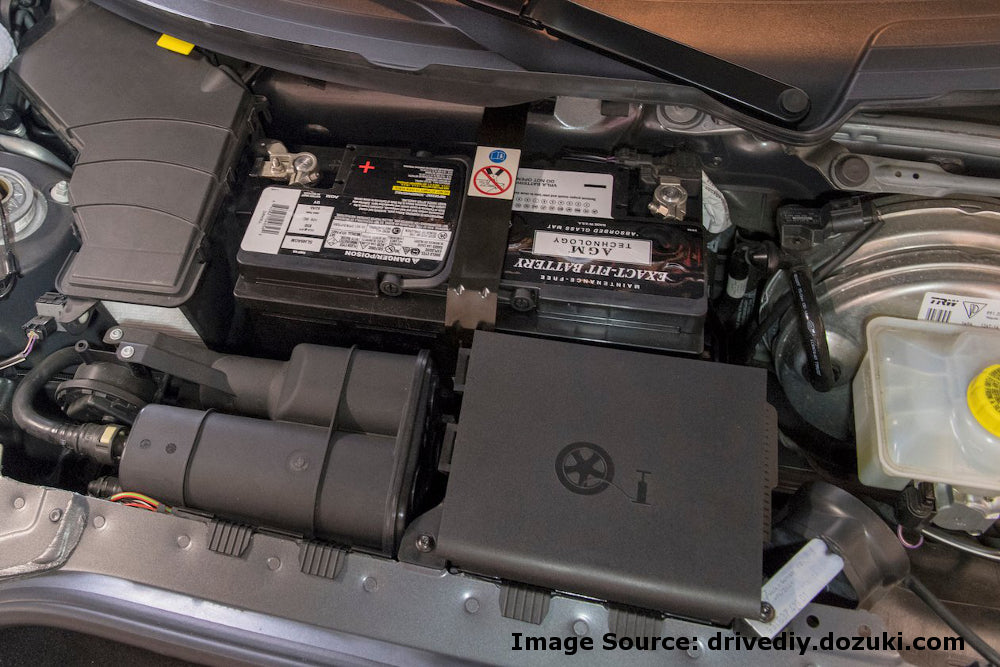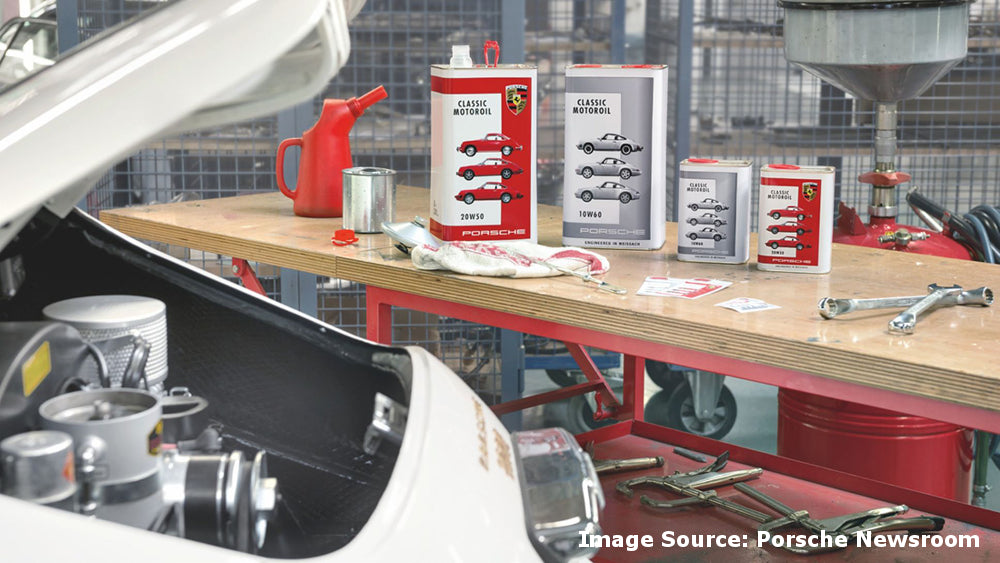In this article, we offer Porsche owners advice on how to select the best battery for their Porsche 911. We start by examining the various starter batteries commonly supplied by Porsche and, after explaining the differences between the various technologies, we offer advice on how to select the best replacement battery for your Porsche 911 and other Porsche applications (old and new).
For close to a hundred years the automotive Lead Acid Battery (LAB) has had a relatively straightforward function: Store electrical power to drive the ignition system, the lights when required and occasionally the starter. For the consumer this made battery selection very simple – battery size, operating voltage, and energy storage capacity were basically all that were needed to successfully select the correct battery.
However, to keep pace with the evolution of the car the choice of LABs has grown, making the selection of a replacement battery a little bewildering at times. So whereas, in the past, all that was required was an understanding of the Battery Council International’s laying out the battery size that best fits the physical installation dimensions and terminal configuration, and the battery’s voltage and capacity, today’s batteries are a little more complex.
Understanding The Battery In Your Porsche 911

When deciding on the best replacement battery for your Porsche, not only do you need to select the physical size and voltage – normally 12-volt, however on earlier classics, such as the Porsche 356, this could be 6-volt – but also the type of battery to best suit your requirements and the vehicle’s operating conditions.
Lead-acid batteries fall into two general categories roughly defined by their architecture:
Flooded Lead Acid Battery
Flooded lead-acid batteries (sometimes referred to as "wet cell" batteries) are the most common type of automotive battery. They have been in use for decades, are well understood, and are the least expensive storage devices. Wet cell batteries are not suited to ‘deep cycling’ such as those encountered with stop-start systems. A full discharge causes strain and each discharge/charge cycle permanently robs the battery of a small amount of capacity. This loss is small while the battery is in good operating condition, but the fading increases once the performance drops to about half the nominal capacity.
On the other hand, the liquid electrolyte ensures good performance at very low ambient temperatures, although battery temperatures above 60oC will result in the accelerated loss of electrolyte.
Sealed Lead Acid Battery
Although no lead acid battery can be totally sealed, these batteries – also sometimes referred to as ‘maintenance free’ or valve-regulated lead-acid – are equipped with valves that control venting during rapid-charge or -discharge by releasing the built-up gases. Rather than submerging the plates in a liquid, the electrolyte is impregnated into a moistened separator, a design that resembles nickel- and lithium-based systems. This also allows these batteries to be operated in any physical orientation without leakage.
Several types of sealed lead acid have emerged over the years with the most common based on a gel electrolyte made up of a silica type gel that suspends the electrolyte in a paste. Gel batteries score highly with their low electrode wear, which results in longer service life in comparison with conventional LABs. However, due to their increased internal resistance gel batteries cannot produce repeated high cold start currents within short intervals.
Over and above their extended lifespan under normal operating conditions, gel-based batteries can also be discharged to lower states of charge than wet-cell batteries without suffering from sulfation. As a result, the battery’s state of health is maintained for longer, even under rapid charge and discharge or when the State of Charge (SoC) drops significantly – such as would be encountered in Porsches equipped with the Auto Start/Stop function.
Selecting The Best Battery For Your Porsche 911 if it’s built with Auto Start/Stop Technology

Start-Stop technology was introduced to reduce exhaust gas emissions and fuel consumption by automatically switching off the engine every time the vehicle comes to a stop. However, Start-Stop systems place a greater load on the battery.
Unlike in conventional vehicles, where the battery only has to provide a large current to turn the starter motor at the beginning of a trip, the Start-Stop battery has to cope with several discharge and recharge cycles over the course of a city drive. Moreover, while the engine is switched off, the battery has to continue powering the ancillary systems such as lights, air conditioning, and in-car infotainment.
A wet-cell LAB operates in a relatively narrow State of Charge window where, if the battery is discharged below its design limits, sulfation increases which reduces the battery’s ability to accept a charge, resulting in a reduced lifecycle.
Batteries designed specifically for ‘deep-draw’ applications on the other hand perform very well under these conditions, albeit at a slightly higher cost.
However, always mindful of the delicate balance between cost and performance, battery manufacturers offer consumers two options:
- At the top of the range is the Absorbent Glass Mat (AGM) battery, best suited to larger, more sophisticated vehicles equipped with stop-start as well as additional energy-saving systems such as brake regeneration and energy management to reduce fuel consumption.
The typical AGM can charge up to five times faster than a wet-cell equivalent, and has the ability to deep cycle, offering a depth-of-discharge of 80 percent, compared to the flooded that is specified at 50 percent, to achieve the same cycle life.
AGM batteries also have a very low internal resistance and are capable of delivering high currents while providing an acceptable service life, even when deep cycled. The technology is also maintenance-free, provides excellent reliability, and is lighter than flooded lead-acid equivalents. These batteries also fare well in low temperatures while offering a low self-discharge rate.
- At the lower end of the start-stop battery price range, the ECM (Enhanced Cyclic Mat), also known as Advanced Flooded Battery (AFB), has been specifically developed to provide increased performance, longer battery life, and the ability to cope with additional cyclic demands at a lower cost than the alternative AGM batteries.
While the above explanations describe why Start-Stop Porsche owners should fit either the AGM or ECB/ AFB type of battery, the question remains: “How does one select a battery that meets the performance and lifespan requirements without paying for functionality that is not required?”
This is a question that pertains to all Lead Acid Batteries, not only in special-case Stop-Start applications.
Tips On Selecting The Best Lead Acid Battery For Your Porsche 911

The rule of thumb is quite simple: Stick to the type of battery that your Porsche left the factory with. This refers to the size, configuration, rating, and technology/ chemistry.
However having said that, there are a few special cases where due to harsh operating conditions, you may wish to upgrade the battery to reduce maintenance or extend the lifetime.
For instance, under higher operating temperatures, where the electrolyte would vent freely with a standard wet-cell battery, the device could be replaced with a VRLA equivalent or even an AGM – both initially costing more but offering less maintenance and improved durability.
If your Porsche operates under a wide range of climatic conditions, particularly colder temperatures, the AGM battery could be considered a very capable, although more costly candidate.
However, it is important to take into consideration that, as with all gel batteries, AGM batteries do not handle overcharging well. They can accept float charge rates of between 2.25 and 2.30V/cell, whereas wet-cell batteries often have a fixed float voltage setting of 2.40V/cell, which means that a direct replacement with a sealed unit could lead to overcharging on a long drive. Therefore it is important to have the alternator’s charge rate checked by an auto-electrician before changing up to an AGM.
Although the trusty LAB is currently the default energy storage device fitted as standard to Porsches requiring a 12-volt starter battery Porsche has also offered an optional lightweight lithium-ion (Li-ion) battery for the Porsche 911 GT3, 911 GT3 RS, and Boxster Spyder since 2010.
Porsche 911’s Lithium-Ion Starter Battery
With an eye on performance and weight saving Porsche was the first carmaker in the world to offer a Li-ion starter battery as an option to the traditional LAB. Weighing less than 6 kg (13 lb), the new battery is more than 10 kg (22 lb) lighter than the equivalent 60 Ah LAB, and is delivered as a separate ‘plug-and-play’ alternative to the conventional starter battery.
Over and above the very obvious weight-saving benefits Li-ion batteries also offer superior deep-draw performance: a conventional LAB only has about 30 per cent of the total capacity available, while a Li-ion battery can repeatedly be drawn down to 20 percent SoC without any impact on lifespan.
The reason for Porsche not offering Li-ion as a factory-fitted option is that, although the lightweight battery offers exceptional performance under most conditions, its starting capacity is limited at temperatures below 0o C (32o F) and as such, it is not unusual in colder climates to temporarily fit a LAB for the winter months! The higher cost of the Li-ion battery also prohibits standard fitment.
Conclusion. What kind of battery do we recommend for your Porsche 911?
Whilst this article seeks to offer a guide to selecting the best battery for Porsches operating in a wide range of environments, it is important that a ‘lesser’ battery, with regards to capacity, technology or performance never be used as a substitute. There might be an upfront saving but the downstream costs and consequences are not worth it.
Having equipped your Porsche with the best battery it is equally important that it is correctly maintained and kept at an acceptable state of charge. In a follow-up article, we’ll cover maintaining electrolyte levels, the specific gravity of the electrolyte, and the best chargers to use to correctly charge your Porsche battery.
Did you enjoy this article? Avoid missing future publications by subscribing to this blog's RSS feed using
https://frazerpart.com/blogs/technical-articles.atom






